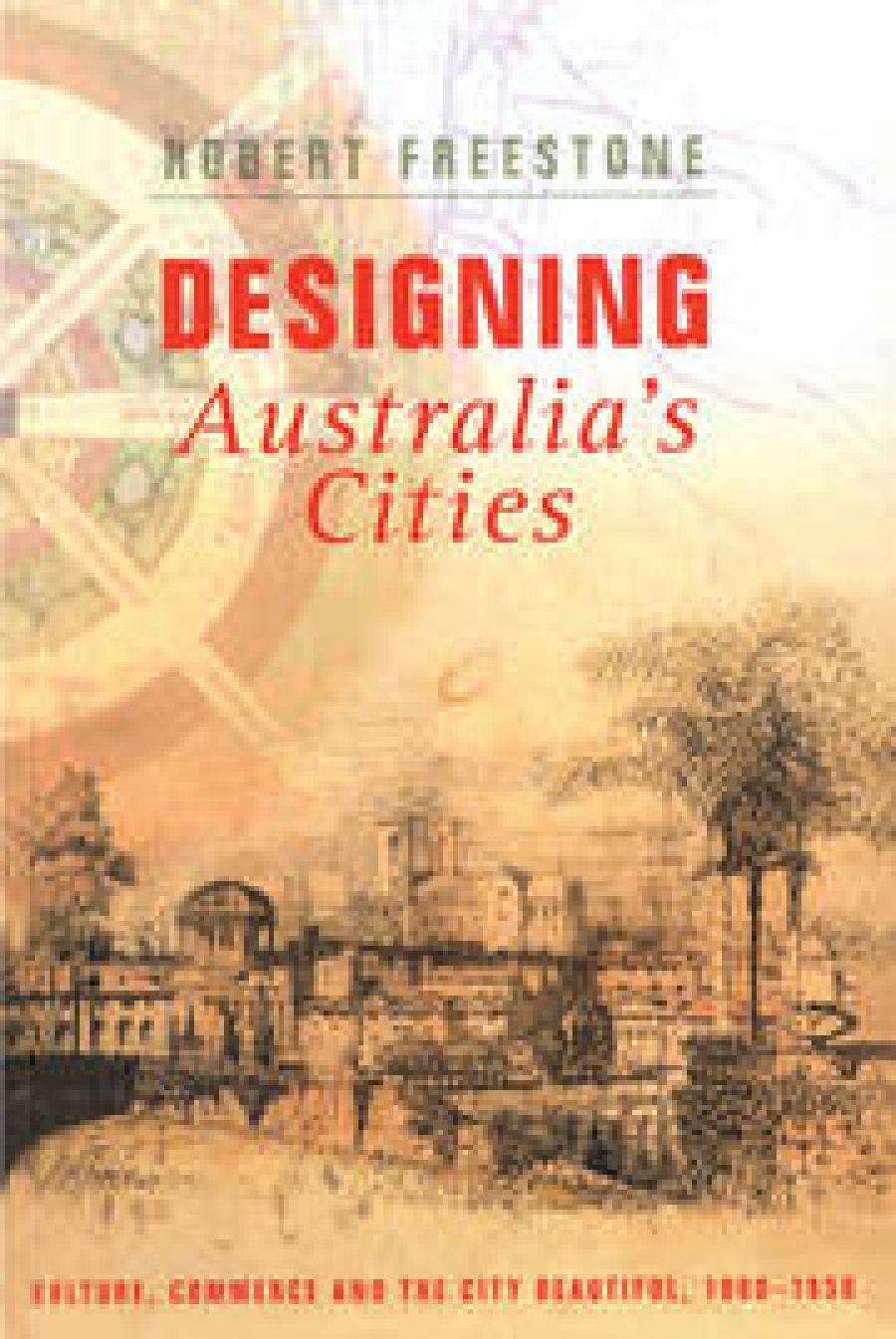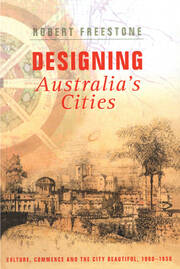
- Free Article: No
- Contents Category: Australian History
- Review Article: Yes
- Article Title: The City Beautiful
- Online Only: No
- Custom Highlight Text:
The planning history of our cities is one that has received surprisingly little attention. While the catalogue abounds in detailed studies – Adelaide and Canberra between them account for the bulk of this literature – national overviews, much less international contexts, are thin on the ground. In this rarefied atmosphere, Robert Freestone has been a generous contributor. His earlier Model Communities: The Garden City movement in Australia (1989) provided a comprehensive overview of urban planning in the period here under review (1900–30). Designing Australian Cities now provides a complementary overlay.
- Book 1 Title: Designing Australia's Cities
- Book 1 Subtitle: Culture, commerce, and the city beautiful 1900–1930
- Book 1 Biblio: UNSW Press, $49.95 pb, 325 pp
- Book 1 Cover Small (400 x 600):

- Book 1 Cover (800 x 1200):

By its very nature, the ‘city beautiful’ went to work on the heart of the metropolis, seeking to pump life into central business districts slowed by the 1890s Depression and still choking from piecemeal colonial developments. Or, so the proselytisers argued. As Freestone points out in his introduction, the ideals of the city beautiful derived from both sides of the Atlantic, and had as their aim a fusion of beauty and utility. The portmanteau of ‘beautility’, coined in the early 1900s by American architect–designer Arnold Brunner, made its journey to the antipodes through a mix of professional designers and hard-nosed agents, the ‘culture and commerce’ of the subtitle.
Freestone’s wide-ranging research and cogent analysis provide a meticulous picture of this largely design-based style of town planning. Until now, the major source on this style, William H. Wilson’s The City Beautiful Movement (1989), has presented a dominant North American narrative, but Freestone’s Australian focus allows British and continental European sources to redress an imbalance. This is not to downplay North American influence on Australia at this time, for it was crucial. Instead, the author is free to use the Australian situation as an international case study in the global transfer and development of town planning ideas. Freestone also sees a distinctively local contribution in the nurture of ‘a nationally distinctive strain of early planning advocacy’.
Freestone’s narrative commences chronologically in the 1890s with the World’s Columbian Exposition, held in Chicago in 1893 to commemorate the four-hundredth anniversary of Columbus’s ‘discovery’ of the Americas. The eclectic array of gleaming neo-classical buildings and structures led to the reproduction of veritable miniature ‘White Cities’ across North America, with municipal buildings and their attendant plazas leading the charge. But to use the word ‘miniature’ is really misleading, as city-beautiful planning was rarely diminutive in thought or deed, and it was the grandiose town plans prepared in the early years of the twentieth century that impressed the hallmarks of this new style. Drawing something from the Beaux-Arts tradition of France and the emerging British town-planning profession, dominated by public health concerns and fresh from its engagement with garden cities, the city beautiful sought to link public improvements with comprehensive planning. ‘Make no little plans,’ wrote American planner Daniel Burnham in 1907; ‘they have no magic to stir men’s blood’.
The majority of us are urban dwellers, but would we recognise a city beautiful if we saw one? Freestone plots its stylistic markers both in physical terms (monumentality, axiality, beauty) and social implications (civic duty, moral obligation, public interest). Think of Geelong’s Johnstone Park (1916–26), with its row of neo-classical public buildings fronting a central boulevard and a neatly sculpted park with its focal bandstand, the product of experienced architect– educator George King and wunderkind designer Percy Everett (in later life Chief Government Architect for the Victorian Public Works Department). Or Brisbane’s Anzac Square (1922–30); the surviving landscape of Sydney’s Hyde Park (1926–34), which accompanied the construction of the Anzac Memorial; and the generous layout of Melbourne’s St Kilda Road and Shrine of Remembrance (1901–34). It is no coincidence that each of these examples features a memorial to the Great War: the conflict provided a significant national imperative for commemoration and new energy for city beautiful planning, which had largely marked time during the wartime interregnum. Another factor highlighted by this small selection is the prolonged date spans between conception and execution – the city beautiful was no quick fix.
This is just a selection. To list Freestone’s chapter headings is to hint at other sites: city plans; civic centres; public spaces; the campus beautiful; parks, parkways and the street beautiful; along with the everyday landscape (an omnibus of urban infrastructure capable of beautification). Wisely, the author devotes an entire chapter to Australia’s federal capital, ‘arguably the highpoint of the city beautiful dream’. According to planners, with the Griffin scheme Australia had by far its best chance ‘of building the much talked-of City Beautiful’. But the dream soon faltered, turning on the question of ‘just how to make artistic planning possible’. Freestone sees Canberra as representative of the city beautiful elsewhere – early excitement, rapprochement with pragmatic goals, and resolution between community expectations, politics and financial constraints.
Whilst I doubt that readers will be tempted to set Freestone’s text to music, in the hands of a composer and librettist there is material for several verismo operas. The Eighth Wonder was perhaps the first Australian opera to take design as its basis, but equally the Griffins and Canberra, the feisty husband-and-wife team George and Florence Taylor, editors and publishers of Building magazine, the municipal socialism of Perth town clerk, William Bold, and Sydney barrister Jack Fitzgerald might all be considered fair game. Had a librettist been let loose, they might have found a more catchy title for the book. Designing Australian Cities is not all that helpful for a book commencing chronologically in the late nineteenth century and concluding in the 1930s. We cannot help wondering what happened in previous decades: let us hope that the author will turn his pen to this neglected area in a subsequent comprehensive overview.
Designing Australia’s Cities sits midway between traditional scholarly erudition and the new ‘lively and accessible’ mode favoured by some publishers. A more perceptive publisher might have sensitively weeded the text of its occasional lecture-theatre overtones, and encouraged a greater integration of illustrations and text. This book is about ideas and outcomes, and for an expansive subject these warrant a generous design and layout. A book just over half as thick but double the page size may have permitted the integration for which I yearned, and at the same time quadrupled the market for this commendable new addition to the literature on Australian history. Curiously, Routledge is publishing a hardback edition for the British market, which seems to undersell the appeal of the book to its principal audience. Still, the market forces which dictate such decisions were also at the core of the city-beautiful movement. Our town planning has often been an uneasy balance between civic ambitions and commercial realities, and this book might stimulate renewed debate of past successes and failures.


Comments powered by CComment